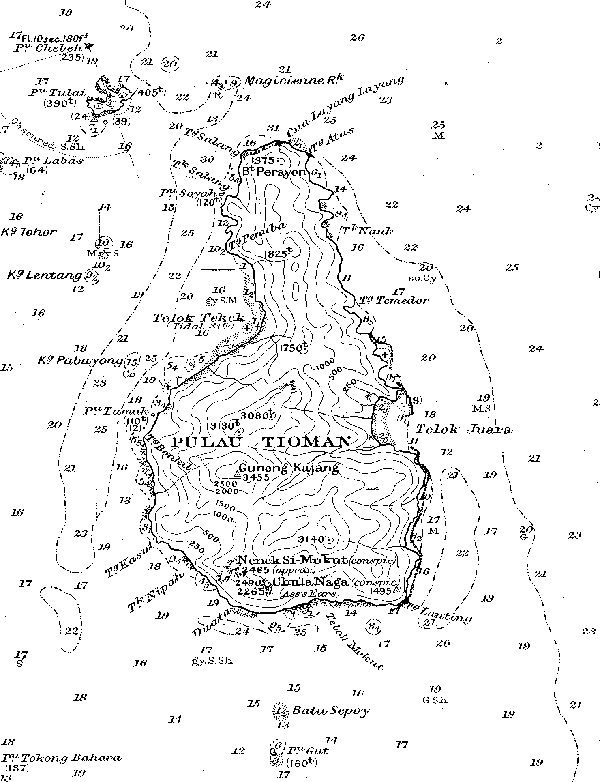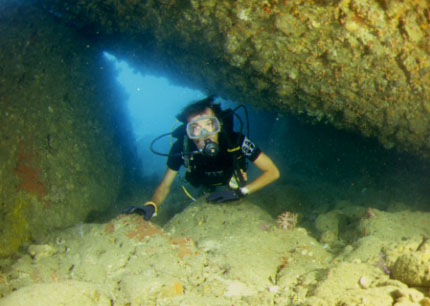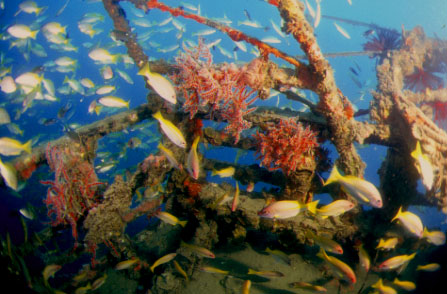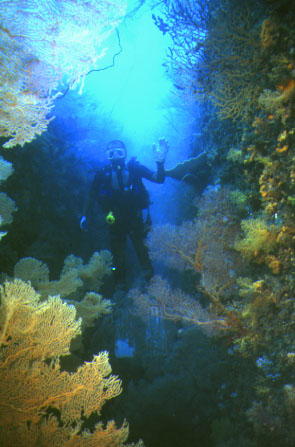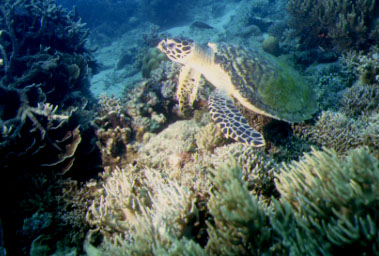Tioman
Introduction
Tioman Island is located 56 km off the east coast of Malaysia. Culminating at 1040 meters, it is surrounded by reefs, but with no road: with the exception of 2 km between the airport and the Berjaya Tioman Resort, the only possible access is by boat... or by foot! With only one or two shops, the island does not offer interests other than diving and resting.
Travel facts
Calendar
| Jan | Feb | Mar | Apr | May | June | July | Aug | Sep | Oct | Nov | Dec |
Diving Sites
-
description :Renggis Islandrating : 3.0type of diving : wreckdepth : 28 mvisibility : 10 m
Located at 100 meters off shore, in front of Berjaya Resort. Quite a lot of fish, but reduced visibility because of the strong current. -
description :Pirate Reefrating : 2.0depth : 4-14 mvisibility : 15 m
Small reef located at 100 m off shore at a depth between 4 and 14 m. Saw one octopus (changing color!), some garfish and a lot of small fish. -
description :Bahara Rockdepth : 10-20 mvisibility : ?
This site and the following sites have not been visited by us.
The most remote of the sites attributed to Tioman, more than 15 miles from Scuba Point, Bahara enjoys, along with Magicienne Rock and Tiger Reef, an undisputed reputation. Reserved for experienced, well-trained divers, the Bahara reef is a masterpiece of nature: the size of the corals is impressive, the colors sublime and the fauna varied. Bahara is also home to the largest number of reef sharks. -
description :Batu Sepoïdepth : ?visibility : ?
Batu Sepoï is a reef between Tioman and Gut, usually used as a second dive on the way back from Pulau Gut. As at Magicienne Rock, large underwater boulders form the substrate of a large, unreported reef. Divers of all levels will find an exuberant fauna, rare coral species and large numbers of nudibranchs and sea worms. -
description :Cadoh Baydepth : 6-20 mvisibility : ?
A geographical extension of Lobster Bay, this site nonetheless has its own ecosystem. A bed of coral-covered rocks stretches out before divers of all levels (depths from -6 to -18 meters). A diverse but sparse fauna inhabits this superb reef: you can spend hours here... and encounter turtles, sharks, triggerfish and rays. A dive without unpleasant surprises. -
description :Chebeh Islanddepth : 15-28 mvisibility : ?
Pulau Chebeh is an island to the north of Coral Island. Its seabed, 14 to 28 meters deep, is a veritable treasure trove of geology and ecology. Large rocks, forming dozens of coral-covered drop-offs, are scattered all around the island. With the help of the current, the experienced diver will evolve in an extraordinary three-dimensional garden: tunnels and canyons punctuate a journey that cannot be completed in a single dive. -
description :Genting Baydepth : 17-28 mvisibility : ?
Opposite Tioman, just 7 miles away, lies a medium-sized boomerang-shaped island: Coral Island (Pulau Tulai in Malay). Populated by monitor lizards and boasting an incredible white sand beach, many tourists love to bask here. But the most interesting of all are the four diving spots that surround it: Genting, Lobster Point, Cadoh Bay and Malang Rock. Genting Bay is certainly the most beautiful site surrounding the island. From -17 to -28 meters, large canyons of rock covered with immense gorgonians and sponges are the stage for multicolored ballets of fish. The CMAS ** (or equivalent) diver will encounter triggerfish, rays, diodons, turtles, blacktip sharks, napoleons, humphead parrotfish and an incredible variety of sand worms and nudibranchs. A drift dive, the current often forces divers to cling to the rocks to take the time to observe. -
description :Golden Reefdepth : 10-20 mvisibility : ?
Golden Reef is the geological continuation of Tiger Reef. This reef, also marked by a buoy, has nothing in common with its two neighbors. It's a geological wrinkle, the northern part of which, less exposed to currents, is covered with all kinds of coral. Many schools of fish pass through here. CMAS** certification is required for this 20-metre dive. -
description :Juara Twin Rocksdepth : ?visibility : ?
Located on the opposite side of the island, Juara Twin Rocks remains one of the lesser-known sites. Two large dark rocks, a few dozen meters from the east coast, like dragon humps, are the center of interest for divers of all levels. Careful of the sometimes violent currents, the water is shallow (8 to 12 meters) and the reef varied. The reef's diverse population includes angelfish, parrotfish, napoleons, sharks and turtles, all of which are rarely disturbed. -
description :Labas Islanddepth : 8-16 mvisibility : ?
An incredible accumulation of large volcanic rocks, Labas, a small islet seven miles north of Tioman, is a local diving hotspot. The program includes caves and grottoes overgrown with coral. Divers (CMAS ** min) glide between walls inhabited by multicolored species. Although shallow (approx. 16 m), a good sense of direction and buoyancy control are required for this unforgettable dive. Beware, however, of the "Titan" triggerfish, which are numerous in this area and particularly aggressive at mating time. The passage through the caves, at around 15 meters, can be avoided in favor of the tip of the rocks, at 23 meters, a current zone where gorgonians and sponges are also very present. -
description :Lobster Baydepth : 1-16 mvisibility : ?
North of Tioman, Lobster Bay is a continuation of the jungle, but underwater. From a few decimeters to sixteen meters deep, it's a veritable carpet of multicolored soft coral, dotted with large volcanic boulders that provide hiding places for multicolored fish. The variety of invertebrates is exceptional. Encounters with big fish are rare, but the scenery is magnificent. -
description :Lobster Baydepth : 20 mvisibility : ?
Continuing on from Genting Bay and just before arriving at Cadoh Bay, huge grey boulders rise up along the length of the island: the eastern side of the island has no beach. Like Genting Bay, it's a drift dive along these rocks at -20 metres. Less colorful because less dense, the reef clings to the walls. In the crevices, you'll come across groupers, lobsters, moray eels and many other surprises. Here, too, the diver will need to demonstrate a certain level (CMAS **). -
description :Magicienne Rockdepth : 5-20 mvisibility : ?
Lost six nautical miles north of Tioman, Magicienne Rock is one of the island's legendary dive spots. Reserved for experienced divers, Magicienne Rock has earned a reputation that's well deserved: it's the most beautiful site in the region. Covered in gorgonian sea fans and myriad corals, three large boulders at 20 meters stand out in the deep blue. Giant manta rays, whale sharks, leatherback turtles... and other exceptional creatures are most often seen at Magicienne Rock (August to November). -
description :Malang Rocksdepth : 5-14 mvisibility : ?
At a maximum depth of 14 meters, this dive around an islet of volcanic rock is partly drift diving. Launch and descent are made at the mooring buoy. On the east side of Malang Rocks, anfractuosities allow the diver to slip into the middle of this rocky mass of prolific life. -
description :Pulau Gutdepth : ?visibility : ?
A small island 5 miles off the south coast of Tioman, Pulau Gut is a superb reef dive. Thanks to its distance from the diving centers, this site, reserved for CMAS ** divers minimum, has retained all its character. The corals are intact and the fauna is easy to get close to. The large rocks forming the drop-offs offer an ideal landscape for underwater photographers. -
description :Sadaweetype of diving : wreckdepth : 28 mvisibility : ?
Sunk in the 80s and randomly found in 1997, Sawadee is a superb Thai boat at -30 meters. Right in the middle of Tekek Bay, Tioman's most beautiful wreck still proudly points its masts and other armaments covered in red coral and concretions. The decks, at -28 and -25 meters, are, apart from a very large number of concretions, in perfect condition. The engine and propeller are still in place, providing hiding places for a dense fauna. On some days, the concentration of fish is so great that it's difficult to see the whole wreck at a glance. CMAS ** or equivalent level required. -
description :Soyak Islanddepth : ?visibility : ?
The last village north of Tioman, Kampung Salang, faces an islet spiked with coconut palms. This modestly sized site is renowned for its variety of nudibranchs and corals. Divers from beginner to advanced will encounter groupers, turtles, moray eels and rays. An easy, relaxing dive. -
description :Taman Lauttype of diving : wreckdepth : 16-22 mvisibility : ?
A sanctuary for fishing boats confiscated and then sunk by the Malaysian authorities, this site offers no fewer than 11 wrecks. Constructed of wood, and of medium size, they are all connected to each other by ends. Between 16 and 22 meters, the experienced diver (minimum CMAS ** or equivalent) will move between compact groups of fry, young hungry barracudas, slightly sticky remora fish, schools of curious platax free of mankind, discovering boats with characteristic designs and fates cut short by human laws. -
description :Tiger Reefdepth : 10-25 mvisibility : ?
Further east of Labas, a superb reef stretches for several hundred meters at an average depth of 22 meters. As soon as you dive in, the experienced diver overhangs a small drop-off, entering an L-shaped siphon. The first stage is a kind of underwater gateway. Schools of fish greet the diver. All around him, life is intense and diverse. Here too, the landscape is dominated by gorgonians and giant sponges. Occasional passage of migrating pelagic fauna. -
description :Tumukdepth : ?visibility : ?
The southernmost site of the bay, Tumuk, is also very little visited by divers. Particularly attractive for beginners, it is home to a pair of humphead wrasse. Diving along the small island, between large volcanic rocks, the diver can observe fine specimens of tropical fish in a garden of varied corals.















